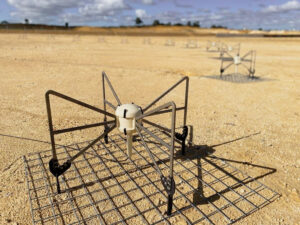ICRAR researchers have developed a portable system that can detect satellites, aircraft and other unusual objects in the sky.
Off the coast of South Carolina, a high altitude balloon made headlines around the world when it was shot down by the US Air Force.
Over the next week, several more objects were shot down over North America, following orders from US President Joe Biden.
US authorities claimed the first object was a foreign spy balloon, carrying intelligence surveillance equipment.
It’s something a prototype radar system developed by ICRAR researchers would likely be able to detect if it flew over Australia.

The 32 antennas of the Portable SDA system are deployed in a circular array 35 metres in diameter. Credit: M. Walker, ICRAR-Curtin.
It’s a system designed for what’s known in defence as “Space Domain Awareness (SDA)”.
ICRAR astronomer Associate Professor Randall Wayth is one of the creators of the radar system.
He says it takes techniques used by scientists to observe the distant Universe and uses them to detect satellites, aircraft and other objects in space.
Stealth Radar
Traditional radar systems send out radio waves from an antenna.
When the radio waves hit an object, they bounce back to the radar, allowing us to ‘see’ objects in the atmosphere.
But ICRAR’s radar system is passive—meaning it only listens for radio waves rather than transmitting them.
Instead, it relies on radio waves transmitted by broadcast TV and FM radio stations, capturing the reflected broadcasts in its receivers.
“Passive radar is advantageous because, since you’re only listening, no one knows you’re doing it,” Associate Professor Wayth says.
“So it’s stealthy and covert if the application is for defence.”
“But it’s also advantageous because we can take advantage of very high-power transmitters used for broadcast.”
“They transmit with much more power than we could do with a portable system.”
In principle, ICRAR’s passive radar system can work anywhere on the planet, because there are so many radio broadcasts.
“It would be hard to find a place that wasn’t illuminated by some transmitters,” he says.
Associate Professor Wayth says it’s actually easier to use the system in remote areas, where there’s less interference.
“So we would look for an environment sufficiently far from transmitters that our receiver systems are not overloaded.”
“Being portable means that we can go wherever we want and target regions of the sky that are of interest.”
From Concept to Prototype
Using the team’s skills in radio astronomy, the entire radar system was developed in just 18 months.
The project has been deployed at both Curtin University and Neerabup—a process that takes four or five people less than two hours.
The system packs down into a standard trailer than can be towed by a four-wheel drive.
“It’s not a difficult thing to deploy, it can be done anywhere by a small team of people quite quickly,” Associate Professor Wayth says.
The project can also be easily duplicated.
“We intentionally tried to reuse as much technology as possible,” Associate Professor Wayth says.

The Portable SDA system deployed at WA’s Australian Automation and Robotics Precinct (AARP) in Neerabup, WA with custom-fitted trailer in the background. Credit: M. Walker, ICRAR-Curtin.
“We’ve gone for commercial receivers and a commercial computing platform. And that actually makes it quite inexpensive.”
A big part of the project was to build local manufacturing capability.
ICRAR engineers designed the antenna components with local manufacturers, with parts produced in Western Australia and South Australia.
Associate Professor Wayth says the radar system can essentially view the entire sky.
“Anything that’s above the horizon will be visible for us,” he says.
“That means we can see aircraft about 50 kilometres away. For objects in orbit, it’s approaching thousands of kilometres.”
Associate Professor Wayth says how sensitive radar is depends on how much signal an object reflects.
But he says the system should be able to detect objects in orbit down to about a metre in size.
“So the large balloons and big satellites… we should certainly be able to detect that,” Associate Professor Wayth says.
ICRAR’s portable Space Domain Awareness project was supported by the Defence Science Centre, an initiative of the State Government of Western Australia.